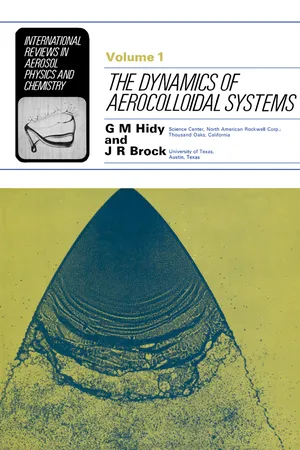
The Dynamics of Aerocolloidal Systems
International Reviews in Aerosol Physics and Chemistry
- 396 pages
- English
- PDF
- Only available on web
The Dynamics of Aerocolloidal Systems
International Reviews in Aerosol Physics and Chemistry
About This Book
The Dynamics of Aerocolloidal Systems, Volume 1 is concerned with the dynamical behavior of idealized aerosol particles in the light of developments in classical mechanics. The idealization is based on the assumption that the solid or liquid particles suspended in a gas can be modeled as macroscopically smooth, chemically inert, spherical bodies. Topics covered include transport processes, single particles, and generation and behavior of clouds. Emphasis is placed on fluid dynamics from the continuum regime to the free molecule regime. This book is comprised of 10 chapters and begins with an overview of definitions and classifications of aerocolloidal suspensions. The next chapter deals with the characteristics of aerial dispersions as provided for in the hard, smooth sphere picture. The basic mechanical parameters of an aerocolloidal system is described, along with certain different regimes of the idealized aerosol and various solutions of the Boltzmann equation. The reader is methodically introduced to the dynamics of single particles in the continuum approximation; heat and mass transfer to single particles in a continuum; formation of aerosols by nucleation of supersaturated vapor; and diffusion and dispersion of aerosol particles. The final chapter considers the interaction between aerosol particles, paying particular attention to the collision of inert spheres whose sticking probability is unity. This volume will be useful to scholars, practicing scientists, and graduate students as well as those who would consider teaching aerosol mechanics as part of a curriculum in the atmospheric sciences, or in other applied sciences including applied physical chemistry, and engineering.
Frequently asked questions
Information
Table of contents
- Front Cover
- The Dynamics of Aerocolloidal Systems
- Copyright Page
- Table of Contents
- PREFACE
- PRINCIPAL NOMENCLATURE
- CHAPTER 1. INTRODUCTION
- CHAPTER 2. FUNDAMENTAL CONSIDERATIONS
- CHAPTER 3. DYNAMICS OF SINGLE PARTICLES IN THE CONTINUUM APPROXIMATION
- CHAPTER 4. HEAT AND MASS TRANSFER TO SINGLE PARTICLES IN A CONTINUUM
- CHAPTER 5. TRANSFER PROCESSES TO SINGLE PARTICLES: THE FREE MOLECULE AND TRANSITIONS REGIONS OF KNUDSEN NUMBER
- CHAPTER 6. TRANSFER PROCESSES TO AN AEROSOL PARTICLE IN THE SLIP FLOW REGION
- CHAPTER 7. DIFFUSION AND DISPERSION OF AEROSOL PARTICLES
- CHAPTER 8. AEROSOL, GENERATION BY DISINTEGRATION AND DISPERSAL
- CHAPTER 9. FORMATION OF AEROSOLS BY NUCLEATION OF SUPERSATURATED VAPOR
- CHAPTER 10. INTERACTION BETWEEN AEROSOL PARTICLES—GROWTH BY COAGULATION OR COALESCENCE
- REFERENCES
- AUTHOR INDEX
- SUBJECT INDEX